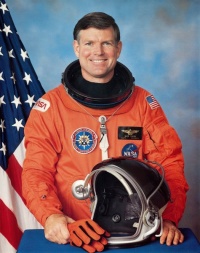Michael L. Coats
From The Space Library
 Michael L. Coats | |
| Birth Name | Michael L. Coats |
|---|---|
| Birth Date | Jan 16 1946 |
| Occupation | NASA Astronaut (former), (Captain, USN, Ret.) |
Contents |
[edit] Personal Data
Born January 16, 1946, in Sacramento, California, but considers Riverside, California, his hometown. He is married to the former Diane Eileen Carson of Oklahoma City, Oklahoma. They have two grown children, a daughter and a son, and two adorable, identical twin granddaughters.
[edit] Education
Graduated from Ramona High School, Riverside, California, in 1964. Received a Bachelor of Science in Naval Science from the United States Naval Academy in 1968, a Master of Science in Administration of Science and Technology from George Washington University in 1977, and a Master of Science in Aeronautical Engineering from the U.S. Naval Postgraduate School in 1979.
[edit] Experience
Coats graduated from Annapolis in 1968 and was designated a Naval Aviator in September 1969. After training as an A-7E pilot, he was assigned to Attack Squadron 192 (VA-192) from August 1970 to September 1972 aboard the USS Kitty Hawk and, during this time, flew 315 combat missions in the Vietnam War. He served as a Flight Instructor with the A-7E Readiness Training Squadron (VA-122) at Naval Air Station, Lemoore, California, from September 1972 to December 1973, and was then selected to attend the U.S. Naval Test Pilot School, Patuxent River, Maryland. Following test pilot training in 1974, he was Project Officer and Test Pilot for the A-7 and A-4 aircraft at the Strike Aircraft Test Directorate. He served as a Flight Instructor at the U.S. Naval Test Pilot School from April 1976 until May 1977. He then attended the U.S. Naval Postgraduate School at Monterey, California, from June 1977 until his selection for the astronaut candidate program. He has logged more than 5,000 hours flying time in 28 different types of aircraft and more than 400 carrier landings.
[edit] Spaceflight Experience
NASA EXPERIENCE: Selected as an astronaut candidate in January 1978, Coats became a NASA astronaut in August 1979. He was a member of the STS-4 astronaut support crew and was a capsule communicator (CAPCOM) for STS-4 and STS-5. From May 1989 to March 1990, he served as acting Chief of the Astronaut Office. He was the pilot on STS-41D (August 30 to September 5, 1984). In February 1985, he was selected as Spacecraft Commander on STS-61H, which was canceled after the Challenger accident. He was the Spacecraft Commander on STS-29 (March 13 to March 18, 1989) and STS-39 (April 28 to May 6, 1991). A veteran of three spaceflights, Coats has logged more than 463 hours in space. STS-41D launched from Kennedy Space Center, Florida, on August 30, 1984. This was the maiden flight of space shuttle Discovery. During this six-day mission, the crew successfully activated the OAST-1 solar cell wing experiment, deployed three satellites (SBS-D, SYNCOM IV-2 and TELSTAR 3C) and operated the CFES III experiment, the student crystal growth experiment and photography experiments using the IMAX motion picture camera. The crew earned the name "Icebusters" for successfully removing hazardous ice particles from the orbiter using the Remote Manipulator System. STS-41D completed 96 orbits of the Earth before landing at Edwards Air Force Base, California, on September 5, 1984. STS-29 Discovery launched from Kennedy Space Center on March 13, 1989. During this highly successful five-day mission, the crew deployed a Tracking and Data Relay Satellite and performed numerous secondary experiments, including a space station "heat pipe" radiator experiment, two student experiments, a protein crystal growth experiment and a chromosome and plant cell division experiment. In addition, the crew took more than 3,000 photographs of the Earth using several types of cameras, including the IMAX 70 mm movie camera. Mission duration was 80 orbits of the Earth and concluded with a landing at Edwards Air Force Base on March 18, 1989. STS-39, an unclassified eight-day Department of Defense mission, launched from Kennedy Space Center on April 28, 1991. The seven-member crew worked around the clock in two-shift operations, during which they deployed, operated and retrieved the SPAS-II spacecraft, in addition to conducting various science experiments, including research of both natural and induced phenomena in the Earth's atmosphere. After completing 134 orbits of the Earth, Discovery and her crew landed at Kennedy Space Center on May 6, 1991.
[edit] Organizations
Member, Society of Experimental Test Pilots; Association of Space Explorers.
[edit] Special Honours
Recipient of the Rotary National Award for Space Achievement (RNASA) National Space Trophy in 2012. Recipient of the JSC Presidential Rank Award in 2009. Elected Fellow of the American Institute of Aeronautics and Astronautics (AIAA) in 2008. Inducted into the Astronaut Hall of Fame in 2007. Awarded the Federation Aeronautique Internationale (FAI) Gold Space Medal in 2006. Recipient of the Defense Superior Service Medal, three Distinguished Flying Crosses, 32 Strike Flight Air Medals, three Individual Action Air Medals, nine Navy Commendation Medals with Combat V, three NASA Space Flight Medals, the NASA Distinguished Service Medal and the NASA Medal For Outstanding Leadership.
[edit] Other Information
Coats retired from the U.S. Navy and the Astronaut Office in August 1991 and joined the corporate arena. From 1991 to 1996 he was Vice President of Avionics and Communications Operations for Loral Space Information Systems. From 1996 to 1998 he was Vice President of Civil Space Programs for Lockheed Martin Missiles and Space in Sunnyvale, California. From 1998 to 2005 he was Vice President of Advanced Space Transportation for Lockheed Martin Space Systems Company in Denver, Colorado. Coats returned to NASA in November 2005 to serve as Director of the Lyndon B. Johnson Space Center in Houston, Texas, until his retirement in December 2012.
[edit] Interview
Read Michael Coats' Oral History interview here.
Dec-12
